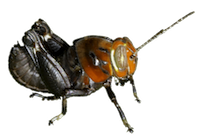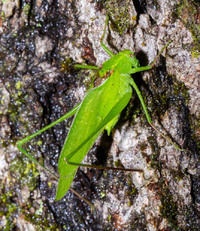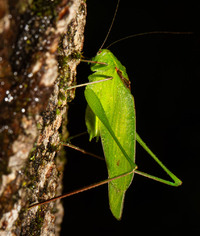Family (Alpha): ACRIDIDAE GRYLLACRIDIDAE GRYLLIDAE GRYLLOTALPIDAE RHAPHIDOPHORIDAE ROMALEIDAE TETRIGIDAE TETTIGONIIDAE TRIDACTYLIDAE
View Tettigoniidae Members:
Conocephalus aigialus Conocephalus allardi Conocephalus brevipennis Conocephalus fasciatus Conocephalus nemoralis Conocephalus nigropleuroides Conocephalus saltans Conocephalus spartinae Conocephalus stictomerus Conocephalus strictus Conocephalus unidentified species Odontoxiphidium apterum Orchelimum agile Orchelimum bradleyi Orchelimum campestre Orchelimum carinatum Orchelimum concinnum Orchelimum erythrocephalum Orchelimum fidicinium Orchelimum militare Orchelimum minor Orchelimum nigripes Orchelimum pulchellum Orchelimum superbum Orchelimum vulgare Orchelimum unidentified species Belocephalus subapterus Bucrates malivolans Neoconocephalus bivocatus Neoconocephalus caudellianus Neoconocephalus ensiger Neoconocephalus exiliscanorus Neoconocephalus melanorhinus Neoconocephalus palustris Neoconocephalus retusus Neoconocephalus robustus Neoconocephalus triops Neoconocephalus velox Neoconocephalus unidentified species Pyrgocorypha uncinata Amblycorypha alexanderi Amblycorypha arenicola Amblycorypha peedee Amblycorypha carinata Amblycorypha floridana Amblycorypha longinicta Amblycorypha oblongifolia Amblycorypha rotundifolia Amblycorypha unidentified species Microcentrum retinerve Microcentrum rhombifolium Montezumina modesta Inscudderia walkeri Scudderia unidentified species Scudderia cuneata Scudderia curvicauda Scudderia curvicauda laticauda Scudderia fasciata Scudderia furcata Scudderia septentrionalis Scudderia texensis Pterophylla camellifolia Atlanticus americanus Atlanticus gibbosus Atlanticus monticola Atlanticus pachymerus Atlanticus unidentified species Hubbellia marginifera Atlanticus davisi Amblycorypha uhleri group NC Records
Amblycorypha floridana (Rehn and Hebard, 1905) - No Common Name
Taxonomy
Family: Tettigoniidae
Subfamily: TettigoniinaeTribe: AmblycoryphiniComments: One of seventeen species in this genus that occur in North America (Cigliano et al., accessed 2024-09-25; Forrest et al., 2023). Eight species have been recorded in North Carolina.Species Status: Belongs to the Oblongifolia Species Group of Rehn and Hebard (1914) and Walker (2004), which in North Carolina, includes oblongifolia , carinata , and floridana . Species in this group have a deep humeral sinus and metasternal lobes that are longer than wide (Walker, 2004).
Identification
Field Guide Descriptions: Capinera et al. (2004) Online Photographs: BugGuide , Google Images ,
iNaturalist , GBIF Technical Description, Adults/Nymphs: Blatchley (1920)SINA 003a.htm Comments: A green katydid similar to the two other members of the Oblongifolia Species Group. Pink forms are known (see BugGuide), as also exist for oblongifolia . The stridulatory field of the males is brown, crossed by a green vein. In the legs of our specimen, the femurs are the same green as the body but the tibiae are largely or partially brown. The dorsal edges of the tegmina are also brown.Total Length [body plus wings; excludes ovipositor]: 25-25.8 mm, males; 21-28.3 mm, females (Blatchley, 1920)Forewing Length: 34.6-35.8 mm, males; 32-36.8 mm, females (Blatchley, 1920)Structural Features: Slightly larger than the other two other members of the Oblongifolia Species Group. The lateral carinae of the pronotum are even more rounded than in oblongifolia , and much more so than the sharply defined carinae in carinata . The stridulatory field is smaller than in oblongifolia , and like carinata , is similar in size to the dorsal side of the pronotum. Like carinata but unlike oblongifolia , the ovipositor is less regularly curved and more finely toothed (Rehn and Hebard, 1914; Blatchley, 1920). Singing Behavior: Songs of this species are described by Capinera et al. (2004) as being much more complex than in the other two members of this group. Each phrase begins with a series of single clicks that increases in rapidity and is followed by a terminal buzz. They characterize it as tick-tick-tick-buz-zz-zz.
Distribution in North Carolina
County Map: Clicking on a county returns the records for the species in that county.
Adult Dates: Click on graph to enlarge
Habitats and Life History
Habitats: The habitats of this species are described as similar to those of the two other species in this group, including shrubby or herbaceous understory vegetation of mesic or wet forests or the herbaceous vegetation growing along the edges of marshes or other wetlands (Blatchley, 1920; Capinera et al., 2004). Our one record, however, comes from a tract of old field vegetation growing around an old farm house located in a very dry area in the Fall-line Sandhills. Diet: Observation Methods: Songs are very distinctive, with most singing done after darkAbundance/Frequency: Adult Phenology:
Status in North Carolina
Natural Heritage Program Status: [W-PK]Natural Heritage Program Ranks: GNR SNR [S1S3]State Protection: Comments: Only one record exists so far in North Carolina. More surveys are needed to document its range, habitat, and conservation status in our state
Image Gallery for Amblycorypha floridana Recorded by: Steve Hall and Bo Sullivan Recorded by: Steve Hall and Bo Sullivan Recorded by: Steve Hall and Bo Sullivan Recorded by: Steve Hall and Bo Sullivan

 »
»


 »
»
